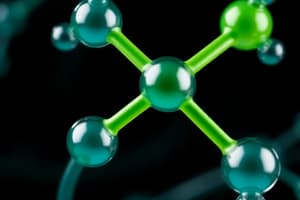Podcast
Questions and Answers
Which branch of chemistry is primarily concerned with studying the chemical processes that occur within living organisms?
Which branch of chemistry is primarily concerned with studying the chemical processes that occur within living organisms?
- Analytical Chemistry
- Inorganic Chemistry
- Biochemistry (correct)
- Physical Chemistry
A scientist observes that a substance readily reacts with an acid. This observation is related to which type of property?
A scientist observes that a substance readily reacts with an acid. This observation is related to which type of property?
- Physical Property
- Chemical Property (correct)
- State of Matter
- Intensive Property
Which of the following is an example of a physical change?
Which of the following is an example of a physical change?
- Burning wood
- Melting ice (correct)
- Rusting of iron
- Decomposition of organic matter
Which of the following mixtures is considered homogeneous?
Which of the following mixtures is considered homogeneous?
A compound is composed of two elements, X and Y, chemically combined in a fixed ratio. If element X has properties very different from those of the compound, what does this indicate?
A compound is composed of two elements, X and Y, chemically combined in a fixed ratio. If element X has properties very different from those of the compound, what does this indicate?
Which state of matter is characterized by having neither a definite shape nor a definite volume?
Which state of matter is characterized by having neither a definite shape nor a definite volume?
What does a chemical formula, such as $H_2SO_4$, represent?
What does a chemical formula, such as $H_2SO_4$, represent?
In a chemical equation, what do the symbols and formulas primarily represent?
In a chemical equation, what do the symbols and formulas primarily represent?
In a chemical reaction, 10 grams of reactant A combine with reactant B to produce product C. If 5 grams of reactant B were used and no other products were formed, what mass of product C would you expect, based on the law of conservation of mass?
In a chemical reaction, 10 grams of reactant A combine with reactant B to produce product C. If 5 grams of reactant B were used and no other products were formed, what mass of product C would you expect, based on the law of conservation of mass?
Which of the following best describes the relationship between heat and temperature?
Which of the following best describes the relationship between heat and temperature?
A chemist performs three successive titrations and obtains the following volumes: 20.00 mL, 20.01 mL, and 20.02 mL. If the true value was known to be 22.00 mL, how would you describe the results?
A chemist performs three successive titrations and obtains the following volumes: 20.00 mL, 20.01 mL, and 20.02 mL. If the true value was known to be 22.00 mL, how would you describe the results?
How many significant figures are present in the measurement 0.01020 m?
How many significant figures are present in the measurement 0.01020 m?
Which of the following describes what happens when an atom becomes an anion?
Which of the following describes what happens when an atom becomes an anion?
Element X has 17 protons, 18 neutrons, and 17 electrons. Which of the following statements correctly describes Element X?
Element X has 17 protons, 18 neutrons, and 17 electrons. Which of the following statements correctly describes Element X?
Which type of chemical bond is characterized by the sharing of electrons between two atoms?
Which type of chemical bond is characterized by the sharing of electrons between two atoms?
Which of the following formulas represents an empirical formula?
Which of the following formulas represents an empirical formula?
In the following reaction: $2H_2(g) + O_2(g) \rightarrow 2H_2O(g)$, which substances are the reactants?
In the following reaction: $2H_2(g) + O_2(g) \rightarrow 2H_2O(g)$, which substances are the reactants?
Which of the following processes is an example of an endothermic reaction?
Which of the following processes is an example of an endothermic reaction?
Flashcards
What is Chemistry?
What is Chemistry?
The study of matter, its properties, and how it changes.
What is Matter?
What is Matter?
Anything that has mass and takes up space (volume).
Analytical Chemistry
Analytical Chemistry
Focuses on the composition of substances.
Physical Properties
Physical Properties
Signup and view all the flashcards
Physical Changes
Physical Changes
Signup and view all the flashcards
Homogeneous Mixtures
Homogeneous Mixtures
Signup and view all the flashcards
Elements
Elements
Signup and view all the flashcards
Compounds
Compounds
Signup and view all the flashcards
Law of Conservation of Mass
Law of Conservation of Mass
Signup and view all the flashcards
Energy
Energy
Signup and view all the flashcards
Potential Energy
Potential Energy
Signup and view all the flashcards
Kinetic Energy
Kinetic Energy
Signup and view all the flashcards
Protons
Protons
Signup and view all the flashcards
Neutrons
Neutrons
Signup and view all the flashcards
Electrons
Electrons
Signup and view all the flashcards
Atomic Number
Atomic Number
Signup and view all the flashcards
Isotopes
Isotopes
Signup and view all the flashcards
Cations
Cations
Signup and view all the flashcards
Study Notes
The provided text contains no new information and exactly matches the existing notes. Therefore, no updates are necessary.
Studying That Suits You
Use AI to generate personalized quizzes and flashcards to suit your learning preferences.




